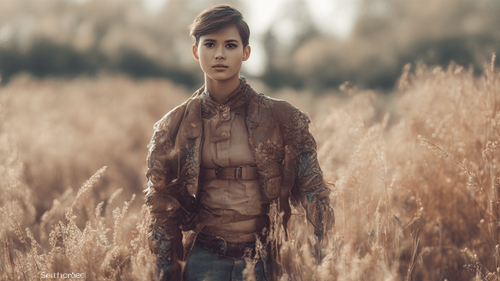
Introduction
In today's digital age, Artificial Intelligence (AI) has made remarkable strides in various fields, including image generation. AI-driven image generation is transforming the way we create visual content, from art and design to marketing and entertainment. In this article, we will delve deep into the world of AI-generated images, exploring its capabilities, applications, and the advantages it brings to the realm of visual creativity.
How Does AI Generate Images?
AI-generated images utilize advanced machine learning algorithms, particularly Generative Adversarial Networks (GANs). GANs consist of two neural networks - the generator and the discriminator - which work in tandem to produce incredibly realistic images. The generator creates images from random noise, while the discriminator's role is to differentiate between real and generated images. As they compete, the generator continuously improves its output until it becomes indistinguishable from real images.
Applications of AI Image Generation
AI image generation finds applications across various industries, revolutionizing the way visual content is created. Some key applications include:
1. Art and Design
AI-generated art has become a fascinating area of exploration for artists and designers. With AI's ability to create unique and innovative patterns, artists can collaborate with AI algorithms to produce extraordinary artworks that challenge traditional notions of creativity.
2. Content Creation
In the realm of content creation, AI-generated images are a game-changer. Content creators and marketers can use AI to quickly generate high-quality images for their blogs, social media posts, and websites, saving time and resources while maintaining visual appeal.
3. Gaming and Animation
The gaming and animation industries have embraced AI-generated images to enhance graphics and create realistic characters and environments. AI's contribution to virtual worlds has added depth and realism to gaming experiences, captivating players worldwide.
4. Fashion and Design
In the fashion and design domain, AI-generated images play a significant role in creating virtual prototypes and conceptualizing new designs. This technology enables designers to visualize their ideas before physically producing them, streamlining the design process.
5. Medical Imaging
AI-generated images have also found applications in medical imaging. By enhancing and reconstructing medical images, AI assists healthcare professionals in diagnosing and treating various conditions more accurately.
Benefits of AI Image Generation
The adoption of AI image generation comes with numerous benefits that have revolutionized various industries:
1. Creative Exploration
AI-generated images open up new possibilities for creative exploration. Artists and designers can break free from conventional constraints and experiment with novel styles and concepts.
2. Time and Cost Efficiency
The automated process of AI image generation significantly reduces the time and resources required to produce visual content. This efficiency is particularly advantageous for businesses with high image demands.
3. Enhanced Personalization
AI-generated images can be tailored to suit individual preferences and requirements, leading to more personalized and engaging visual experiences for users.
4. Improved Decision Making
In fields like fashion and design, AI-generated images aid in making informed decisions by providing visual representations of ideas, enabling stakeholders to visualize the end product accurately.
5. Mitigation of Creative Block
Creatives often face creative block while trying to come up with original ideas. AI-generated images can act as a source of inspiration, helping them overcome creative hurdles.
FAQs (Frequently Asked Questions)
What is the role of GANs in AI image generation?
GANs, or Generative Adversarial Networks, play a vital role in AI image generation. They consist of two neural networks - the generator and the discriminator - working in opposition. The generator generates images from random noise, while the discriminator's task is to differentiate between real and generated images. As they compete, the generator's ability to create realistic images continuously improves.
Can AI-generated images replace human creativity?
AI-generated images are a powerful tool that can enhance human creativity, but they cannot replace it entirely. While AI can create impressive visual content, it lacks human emotions, intuition, and artistic vision. Human creativity and AI-driven image generation can collaborate to achieve groundbreaking results.
How does AI image generation impact copyright and intellectual property?
AI-generated images raise intriguing questions about copyright and intellectual property rights. As AI creates images autonomously, determining ownership can be challenging. Legislation and ethical frameworks are continuously evolving to address these concerns and ensure fair attribution and protection for creators.
Is AI image generation accessible to everyone?
The availability of AI image generation tools and technologies has expanded in recent years, making them more accessible to a broader audience. While advanced AI models may require technical expertise, user-friendly platforms and applications cater to those without extensive programming knowledge.
What are the ethical considerations surrounding AI-generated images?
AI-generated images pose ethical considerations, such as the potential misuse of the technology for misinformation or deepfake creation. As with any AI application, responsible use and ethical guidelines are necessary to prevent negative implications and promote positive outcomes.
Can AI-generated images contribute to scientific research?
AI-generated images have proven valuable in scientific research, particularly in fields like astronomy and biology. They aid in visualizing complex data, simulating environments, and generating models, assisting researchers in understanding phenomena and developing new insights.
Conclusion
AI-generated images have emerged as a transformative force in visual creativity, offering novel opportunities for artists, businesses, and industries alike. As AI technologies continue to advance, the synergy between human creativity and AI-driven image generation will reshape how we envision and create visual content. Embracing this evolution responsibly and ethically will unlock a world of endless creative possibilities and societal advancements. Explore the potential of AI image generation and embark on a journey of innovative and captivating visual experiences.